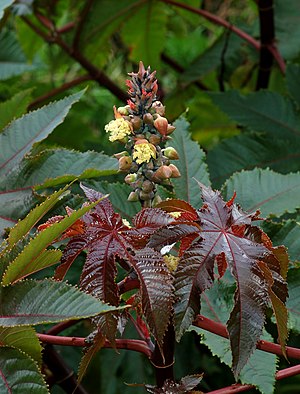Ricinus communis
ἀσκεῖν περὶ τὰ νοσήματα δύο, ὠφελεῖν ἢ μὴ βλάπτειν → strive, with regard to diseases, for two things — to do good, or to do no harm | as to diseases, make a habit of two things — to help, or at least, to do no harm
Latin > Greek
σιλλικύπριον, σιλικύπριον, κροτών, σίλι, σέσελι Κύπριον, κίκι, κῖκι
Wikipedia EN
Ricinus communis, the castor bean or castor oil plant, is a species of perennial flowering plant in the spurge family, Euphorbiaceae. It is the sole species in the monotypic genus, Ricinus, and subtribe, Ricininae. The evolution of castor and its relation to other species are currently being studied using modern genetic tools. It reproduces with a mixed pollination system which favors selfing by geitonogamy but at the same time can be an out-crosser by anemophily (wind pollination) or entomophily (insect pollination).
Its seed is the castor bean, which, despite its name, is not a bean (that is, the seed of many Fabaceae). Castor is indigenous to the southeastern Mediterranean Basin, Eastern Africa, and India, but is widespread throughout tropical regions (and widely grown elsewhere as an ornamental plant).
Castor seed is the source of castor oil, which has a wide variety of uses. The seeds contain between 40% and 60% oil that is rich in triglycerides, mainly ricinolein. The seed also contains ricin, a highly potent water-soluble toxin, which is also present in lower concentrations throughout the plant.
The plant known as "false castor oil plant", Fatsia japonica, is not closely related
Translations
af: kasterolieboom; am: ጉሎ; ar: خروع; arz: خروع; azb: گنه گرچک; az: gənəgərçək; be: клешчавіна; bg: рицин; bh: रेणि; bn: ভেন্না; ca: ricí; ceb: tangantangan; cs: skočec obecný; cv: ăвăш; cy: trogenllys; da: ricinus; de: Wunderbaum; dty: अँडिर; el: ρίκινος; et: riitsinus; eu: akain-belar; fa: کرچک; fi: risiini; frr: ritsinus; fr: ricin commun; ga: planda ola ricne; gl: rícino; gn: mba'ysyvo vai; grc: σιλλικύπριον, σίλι, σέσελι Κύπριον, κίκι, κῖκι; gu: દિવેલી; ha: zirman; he: קיקיון מצוי; hi: अरंडी; hr: ricinus; hsb: wšědny ricinus; ht: maskreti; hu: ricinus; hy: տզկանեփid: jarak; ja: トウゴマ; ka: აბუსალათინი; kk: үпілмәлік; kn: ಔಡಲ; ko: 피마자; ku: kerçik; la: Ricinus communis; lt: paprastasis ricinmedis; lv: rīcinaugs; mk: рицинус; ml: ആവണക്ക്; mr: एरंड; ms: pokok jarak; my: ကြက်ဆူပင်; ne: अँडिर; new: अलःमा; nl: wonderboom; nn: kristpalme; no: ricinus; oc: ricin; os: касторгæрдæг; pam: tangan-tangan; pa: ਅਰਿੰਡ; pl: rącznik pospolity; pnb: ارنڈ; ps: ارهنډه; pt: mamona; ro: ricin; ru: клещевина; rw: ikibonobono; sat: ᱮᱨᱟᱸᱰᱚᱢ; sa: एरण्डसस्यम्; sd: ھيرڻ; simple: castor oil plant; sr: ricinus; su: jarak; sv: ricin; ta: ஆமணக்கு; te: ఆముదం చెట్టు; th: ละหุ่ง; tl: lansina; to: lepo; tr: hint yağı bitkisi; ts: nhlampfurha; uk: рицина; uz: kanakunjut; vi: thầu dầu; wuu: 蓖麻; zh_yue: 蓖麻; zh: 蓖麻

